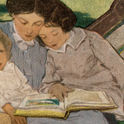When a parish member mentioned the word Zoom to Reverend Simon White a few weeks ago, he thought they were talking about an ice lolly—specifically, the rainbow-coloured sister to the better-known Fab. “I thought, ‘oh that’s one of those ice creams you used to get for 20p or so'—I’d never heard of any video app.”
Since then, White has used the California-based streaming platform almost every day to live-stream funerals from Morpeth Parish Church in Newcastle to families forced to self-isolate at home. Last week, he used it to broadcast a child’s funeral to grieving family members around the world.
Zoom has become the unexpected buzzword of the pandemic, with daily users ballooning from 10m in December to 200m last month, as people huddled around their screens for book clubs, Easter services and even cabinet meetings. But a rather more solemn footnote of the virus has been the use of Zoom to live-stream funerals.
In his era-defining speech announcing the British lockdown three weeks ago, Boris Johnson emphatically—and rather morbidly—exempted funerals from a list of banned social events, and instead ordered attendees to comply with social distancing rules.
But as the UK death toll surpasses 16,000 fatalities, even a two metre distance seems insufficient. With councils such as Bradford and Leeds banning all funerals, and the Church of England recommending that all ceremonies be live-streamed, religious figures like Reverend White have been forced to trade their lecterns for laptops. For many religions, this has caused profound changes to long-held funerary traditions.
As Londoners gathered round their webcams to break Deliverooed matzah during Passover celebrations this month, many in the Jewish community were congregating for rather more sombre reasons. For those sitting shiva—the week-long period of collective mourning—social distancing rules have uprooted normality. Shivas usually take place within the home of the deceased, and are largely social events, revolving around food-sharing, garment-tearing and communal prayer.
For Rabbi Helen Freeman, Zoom seemed the natural substitute to sit shiva for a much-loved matriarch of her congregation at the West London Synagogue. “Doing it via Zoom meant we had about 200 participants, much more than could possibly fit into any house,” she says. “Because so many people who loved her were on the call, it actually felt really lovely and like an extended family.”
In many cases, streaming apps appear to offer a solution for dispersed family members unable to board a flight or clock off work for a funeral. But for others in the Jewish community, performing rituals on platforms such as Zoom has raised questions regarding spiritual legitimacy.
In Jewish tradition, at least 10 adult males are required to form a minyan—the quorum necessary for public worship. Without one, traditional Jewish services and prayers central to a shiva cannot be legitimately held. In Rabbi Freeman’s case, whether or not the pixelated presence of her shiva attendees constituted “presence” as stipulated in the Torah has become a matter of stiff debate. Zoom, then, seems not only to be providing temporary relief in a time of crisis—it is also sparking a revaluation of religious tradition.
In Islamic convention, burial services are usually held within 24 to 48 hours of death. Muslim funerals are therefore almost always swiftly-arranged affairs, for which the jump to streaming apps like Zoom seems a welcome evolution.
But for Zainab Gulamali, Public Affairs Manager at the Muslim Council of Britain, live-streaming the funeral of a friend’s father did more than just provide a virtual sense of consolation—it offered her a glimpse to a side of Islam she otherwise never would have seen.
“In the Muslim tradition, women don’t go to the burial. They’re allowed to attend the prayers beforehand, but not the burial. So for me, it was the first time I have ever ‘been’ to one.” This is nothing to be taken lightly, Gulamali notes. “It’s a big shift in Islam. For maybe the first time in history, women on a wide scale are seeing another side of things.”
Female access to funerals is prohibited in various religions. “In many different cultures, women are protected from the raw physicality of death,” says Tony Walter, Professor Emeritus of Death Studies at the University of Bath. “In various fringes around the UK, women go to church services, then go home to finalise the ham sandwiches.”
Elsewhere, Walter explains, mourners are often stifled by the British stiff upper lip tradition—“There’s that telling comment when people exit the crematorium and say: ‘wasn’t she brave,’ about the wife in the front row whose lip was trembling but didn’t crack.”
The move of funerals online, therefore, might prove emancipatory across the religious spectrum. On video apps like Zoom, mourners can freely express themselves from the comfort of their own homes, and the option of muting one’s camera or turning off video entirely takes the pressure off needing to pare down their emotions.
At his Anglican church in Newcastle, Reverend White has seen a surge in attendance for funerals on Zoom. “In some cases, I’m used to having four or five people for a service, but on Zoom, hundreds of family members are tuning in from all over the world. Because people can mute themselves or turn their cameras off, they feel they can be more emotional,” White says.
“They’re more comfortable on the back row—the virtual back row, if you like... And I think that’s really changing the way we think about things at the church.”
The extent to which these temporary alterations will calcify into permanent changes to religious tradition is yet to be seen. After all, streaming technology is nothing new in the funeral industry. British crematoria—or “crems,” as they are called by those in the know—have led the charge in upping accessibility for far-flung family members over the past few years. But until now, there has been little impetus to bring video technology into the mainstream.
“The funeral industry is deeply conservative. Death is a taboo subject, so when it comes along, people hardly want to be revolutionaries,” explains Walter. “But the pandemic might just act as a stimulus for wide-scale change.”
Historically, evolution in the funeral tradition has come about via dramatic events, rather than incremental change. Hygiene scruples during the Spanish Influenza stubbed out the Victorian tradition of grandiose, horse-drawn funeral processions in the UK. “Similarly,” says Walter, “Elton John performing at Princess Diana’s funeral laid the ground for the move away from hymns at religious funerals to more secular practices.”
And there’s no reason why changes brought about during the pandemic won’t take hold, he adds. “Big events like this don’t create change out of nothing—they act as the catalyst to kick along change that was ready to happen.”
“The main thing to note is that people are having to be creative—and when people are creative they force real changes in tradition.”













